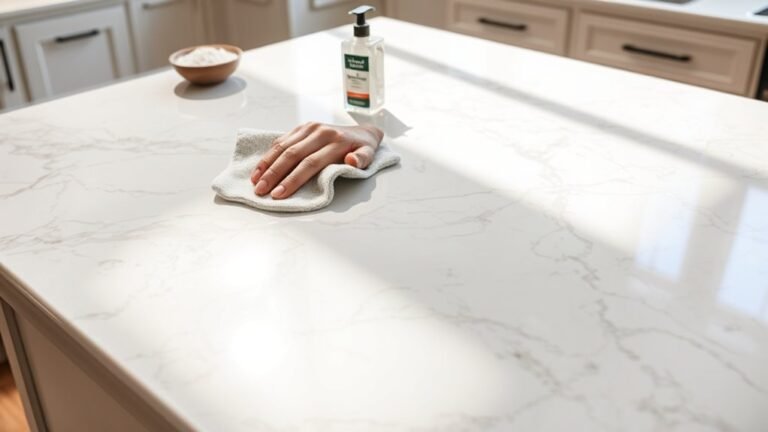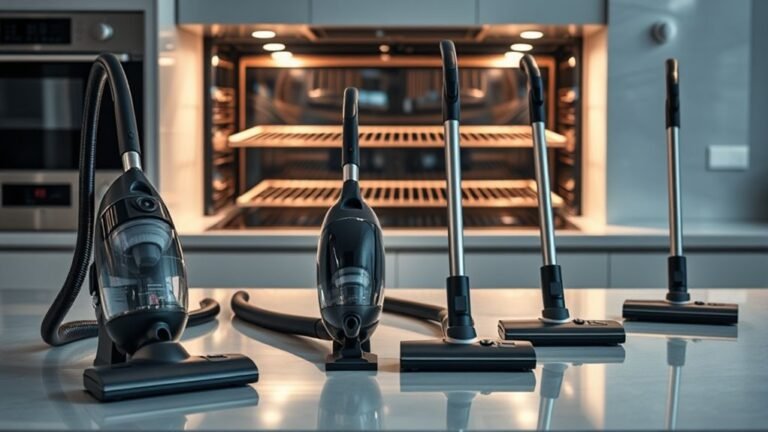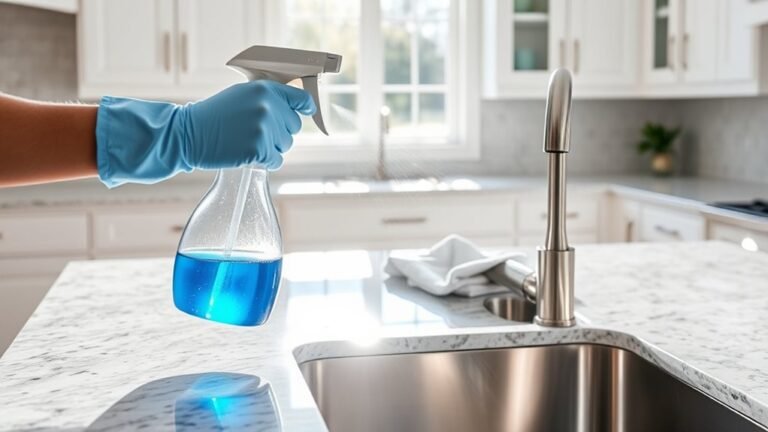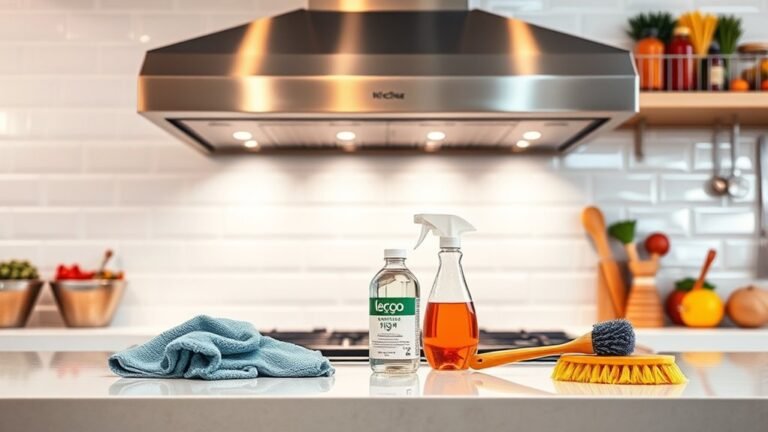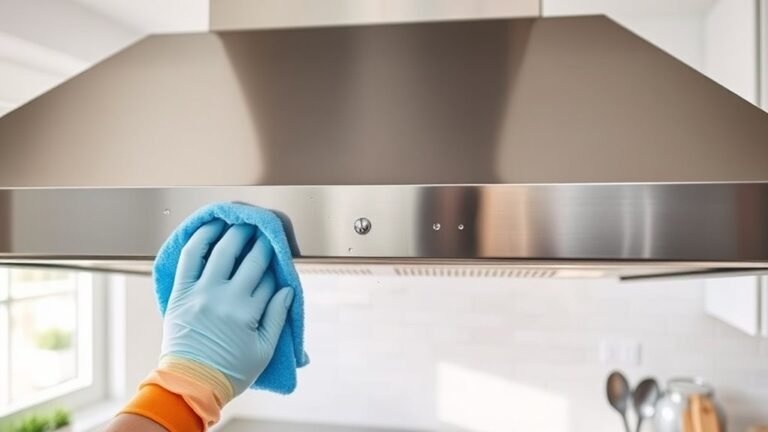Cleaning Tips Before and After Range Hood
Before using your range hood, verify it’s free of dust and grease by wiping down exterior surfaces and checking filters. After cooking, clean the filters by soaking them in hot soapy water or using a degreaser, then wipe the hood’s interior and exterior to remove residue. Regular maintenance prevents buildup and maintains airflow. Turn off power before cleaning for safety, and clean filters monthly or as needed. For detailed steps and professional care tips, keep exploring the essential practices that protect your hood’s efficiency.
Understanding Your Range Hood Components

A range hood consists of several key components that work together to remove smoke, grease, and odors from your kitchen. When you understand the different range hood types—such as under-cabinet, wall-mounted, island, and downdraft—you can better select the right model for your space. At the heart of every range hood is the filter, which captures airborne grease and particulates. Filter materials vary, including aluminum mesh, stainless steel baffle, and charcoal for ductless models. Each material demands specific cleaning methods to maintain efficiency and longevity. Knowing these components allows you to clean effectively and maintain your hood’s performance, giving you the freedom to cook without worries about lingering odors or grease buildup. Proper care will keep your kitchen fresh and your range hood functioning efficiently.
Preparing Your Kitchen for Cleaning
Before you begin cleaning your range hood, it’s important to prepare your kitchen properly to guarantee safety and efficiency. Start by clearing the area around the hood, ensuring your kitchen organization supports easy access to all components. Establish a cleaning schedule to keep your efforts regular and manageable. Follow these steps:
Proper preparation and regular scheduling ensure safe, efficient range hood cleaning and easy access to all parts.
- Remove any flammable items near the range hood to prevent accidents.
- Turn off the power supply to the hood for safety.
- Lay down protective coverings on counters and stovetop to catch drips.
- Organize cleaning tasks by priority to streamline the process.
Tools and Supplies Needed for Cleaning

Once your kitchen is prepped and safe for cleaning, gathering the right tools and supplies will make the process efficient and effective. You’ll need essential tools like a soft cloth or microfiber towels, a non-abrasive sponge, and a soft-bristle brush to reach tight spots without damaging surfaces. Cleaning supplies should include a degreaser or mild detergent, warm water, and a spray bottle for easy application. Don’t forget gloves to protect your skin and a bucket to rinse your tools. If your range hood has removable filters, consider having a basin large enough for soaking them. Having these essential tools and cleaning supplies at hand guarantees you can methodically tackle every part of your range hood, enabling you to maintain a clean, fresh kitchen environment with ease.
Step-by-Step Cleaning Before Using Your Range Hood
Cleaning your range hood thoroughly involves a few essential steps that guarantee all grease and grime are removed effectively. Before you start, consider your range hood placement and cooking habits to tailor your cleaning approach.
Thoroughly clean your range hood by considering its placement and your cooking habits for best results.
- Turn off the power and make certain the hood is cool to prevent accidents.
- Remove the filters carefully; these trap most grease and need soaking.
- Use a degreaser or warm soapy water to clean the interior surfaces, focusing on areas affected by your cooking style.
- Rinse and dry parts completely before reassembling to avoid moisture buildup.
Step-by-Step Cleaning After Using Your Range Hood

Maintain your range hood’s efficiency by wiping down its exterior and controls after each use. This simple step prevents grease buildup and keeps your kitchen fresh. Adhering to a regular cleaning frequency is key—wipe surfaces daily or after heavy cooking sessions. Use a microfiber cloth dampened with mild detergent and warm water, applying the proper technique: gentle, circular motions to avoid damaging finishes. After wiping, dry surfaces thoroughly to prevent streaks and corrosion. Check vents and light covers for residue; clean them with the same care. By following this methodical approach, you guarantee your range hood operates at peak performance and lasts longer, giving you the freedom to cook without worry. Consistency and correct technique make all the difference in maintaining a clean, efficient appliance.
How to Clean and Maintain Filters
After wiping down the exterior, your attention should turn to the filters, which play a key role in trapping grease and airborne particles. Proper cleaning and maintenance extend their filter lifespan and guarantee efficiency. First, identify your range hood’s filter types—common ones include mesh, baffle, and charcoal. Each requires specific care. Here’s how to maintain them:
- Remove filters carefully to avoid damage.
- Soak metal filters in hot soapy water or use a degreaser; rinse thoroughly.
- Replace charcoal filters as recommended, since they aren’t washable.
- Dry filters completely before reinstalling to prevent mold or damage.
Maintain a regular cleaning schedule based on use frequency and manufacturer guidelines, preserving your freedom from clogging and maintaining peak air quality in your kitchen.
Tips for Preventing Grease Build-Up
You’ll want to establish a regular wiping routine to keep grease from settling on your range hood surfaces. Using degreasing sprays specifically designed for kitchen appliances can break down stubborn buildup effectively. Additionally, maintaining proper ventilation guarantees that grease particles don’t accumulate excessively in the first place.
Regular Wiping Routine
Regularly wiping down your range hood is essential for preventing grease build-up that can impair its function and create unpleasant odors. Establishing a consistent wiping frequency is key to maintaining your appliance’s efficiency and prolonging its lifespan. Create a cleaning schedule that fits your cooking habits—more frequent if you cook daily, less if you use it occasionally.
Consider these practical tips for your routine:
- Wipe surfaces with a damp microfiber cloth after each use.
- Clean the exterior weekly to remove surface grease.
- Address stubborn spots promptly to avoid accumulation.
- Schedule a deep clean monthly to maintain peak performance.
Use Degreasing Sprays
One effective method to combat grease build-up on your range hood is by using degreasing sprays designed specifically for kitchen appliances. Start by selecting degreaser options that suit your hood’s material—look for non-abrasive, food-safe formulas. Before application, verify the surface is cool and dry. Apply the spray evenly, covering all greasy areas without oversaturating. Let the degreaser sit for the recommended time to break down stubborn grease effectively. Use a soft cloth or sponge to wipe away residues, following methodical, circular motions to avoid streaks. Rinse with a damp cloth if the product instructions advise, then dry thoroughly to prevent moisture accumulation. Employing these precise application techniques regularly will keep your range hood clean, maintaining both its efficiency and your kitchen’s freedom from grease build-up.
Ventilation Maintenance Tips
Maintaining proper ventilation is essential to preventing grease build-up in your range hood and ductwork. It directly affects air quality and filter efficiency, so staying proactive is key. To keep everything running smoothly, follow these ventilation maintenance tips:
- Regularly clean or replace filters to guarantee maximum filter efficiency.
- Inspect ductwork for grease accumulation and clean it periodically to maintain airflow.
- Use your range hood every time you cook to reduce airborne grease particles.
- Schedule professional duct cleaning annually to preserve air quality and system performance.
When to Schedule Professional Maintenance
Although you can handle routine cleaning yourself, knowing when to schedule professional maintenance is crucial to keep your range hood functioning efficiently. Frequency recommendations suggest a professional inspection at least once a year, but this can vary based on your cooking habits and hood usage. Pay close attention to maintenance signs such as unusual noises, reduced airflow, or persistent grease buildup that cleaning doesn’t resolve. These indicators signal deeper issues requiring expert attention. Scheduling timely professional service guarantees thorough filter replacement, duct cleaning, and motor checks, preserving your range hood’s performance and extending its lifespan. By adhering to these guidelines, you maintain peak ventilation and enjoy the freedom of a clean, safe kitchen environment without unexpected breakdowns or costly repairs.
Frequently Asked Questions
Can I Use Natural Cleaners Instead of Chemical Products on My Range Hood?
You can definitely use natural cleaners instead of chemical products on your range hood. A vinegar solution works wonders for cutting grease and disinfecting surfaces without harsh fumes. Just mix equal parts water and vinegar in a spray bottle for an effective cleaner. Citrus spray is another great option, offering a fresh scent and natural degreasing power. These natural alternatives give you the freedom to clean thoroughly while keeping your kitchen environment safer and eco-friendly.
How Often Should I Replace My Range Hood Filters?
You should pay close attention to filter maintenance to guarantee your range hood works efficiently. Generally, you’ll want to replace your filters every 3 to 6 months, depending on your cooking habits and filter type. If you cook frequently or use greasy oils, replacements might be needed more often. Keep an eye on filter condition and odors; timely replacement helps maintain air quality and prolongs your range hood’s lifespan.
Are There Any Safety Precautions When Cleaning Electrical Components of the Hood?
When cleaning electrical components of your range hood, always prioritize electrical safety. Make sure to unplug the unit before starting to avoid any risk of shock. Wearing safety gear like insulated gloves can protect you further. Use a dry cloth instead of water or liquids near electrical parts. Take your time, work methodically, and never rush, so you maintain your freedom to clean safely without accidents.
What Types of Range Hoods Require the Least Maintenance?
Did you know ductless hoods can reduce maintenance by up to 30% compared to traditional systems? If you want the least upkeep, ductless hoods are ideal since they don’t require ductwork cleaning. Wall mounted hoods, especially those with stainless steel filters, also demand less frequent attention. You’ll enjoy more freedom without constant cleaning, focusing on cooking instead of maintenance. Choose wisely to streamline your kitchen routine efficiently.
Can a Dirty Range Hood Affect Indoor Air Quality?
Yes, a dirty range hood can greatly affect your indoor air quality. When grease buildup accumulates on filters and surfaces, it traps airborne pollutants instead of filtering them out. This leads to poor ventilation, allowing harmful particles and odors to circulate freely in your space. By keeping your range hood clean, you guarantee efficient removal of contaminants, maintaining a healthier, fresher environment where you can breathe easy and enjoy your freedom without worrying about indoor pollution.

